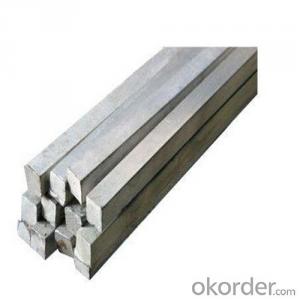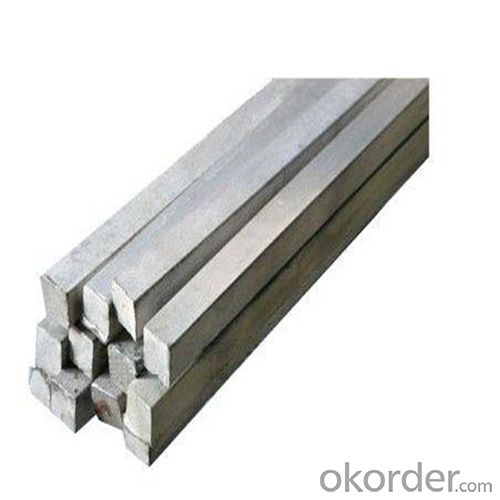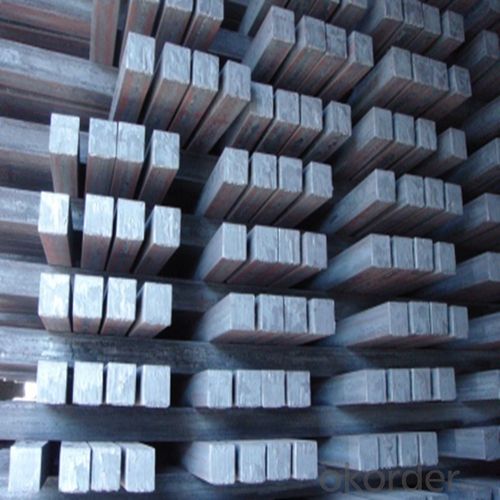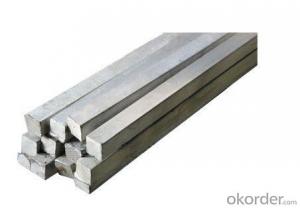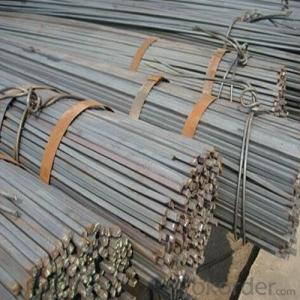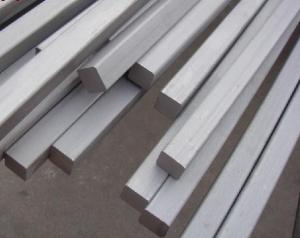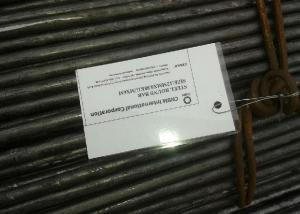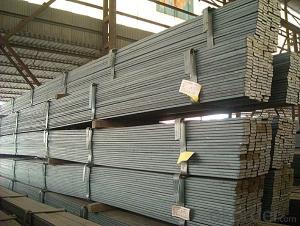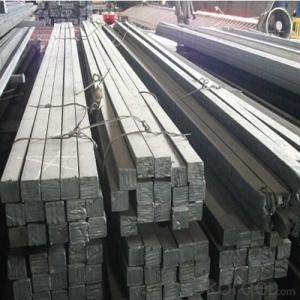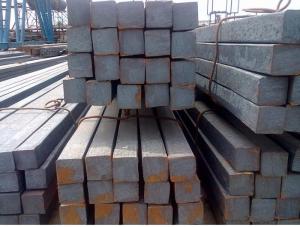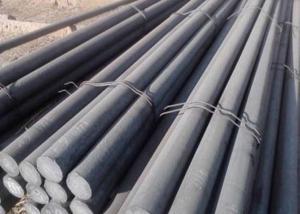Steel Square Straight Bars Chinese Standard
- Loading Port:
- Tianjin
- Payment Terms:
- TT OR LC
- Min Order Qty:
- 25 m.t.
- Supply Capability:
- 1000 m.t./month
OKorder Service Pledge
OKorder Financial Service
You Might Also Like
1. Structure of Steel Square Straight Bars Chinese Standard Description:
Steel square straight bars Chinese standard is a bar with square shaped cross-section. It is special case of equal sides. Before steel products are sold on the market, the steel must first be processed into more functional pieces. Raw steel cannot be of use while in its pure form, thus it has to be cast into shape. The freshly made steel, steel square straight bars Chinese standard is still in the form of a metal bar or rectangle. Small sizes of Steel square straight bars Chinese standard are used in ship building.
2. Main Features of Steel Square Straight Bars Chinese Standard :
• Grade: Q235
• Type: Mild carbon steel
• A quadrilateral with four equal sides and four right angles.
• Vibration: The stiffness and mass are chosen to prevent unacceptable vibrations, particularly in settings sensitive to vibrations, such as offices and libraries.
• Local yield: Caused by concentrated loads, such as at the beam's point of support.
3. Steel Square Straight Bars Chinese Standard Images:
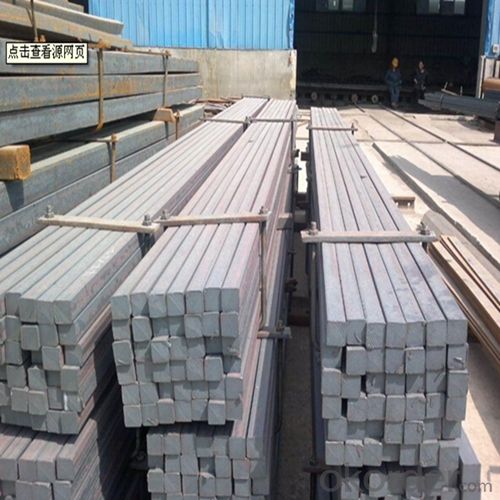
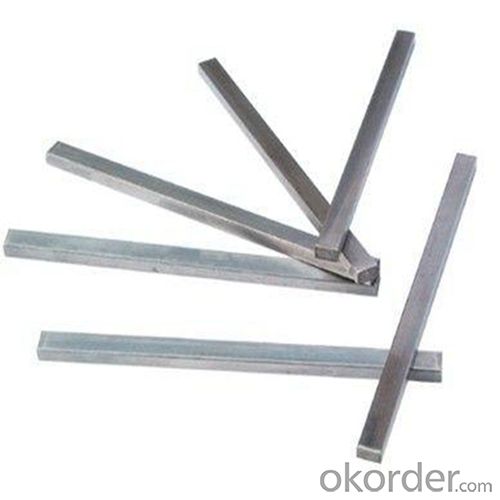
4. Steel Square Straight Bars Chinese Standard Specification:
Mechanical Properties | Grade | Steel diameter(mm) | |||
≤16 | 16~40 | 40~60 | 60~100 | ||
Yield Point Δs/MPa | Q195 | ≥195 | ≥185 | - | - |
Q235 | 235 | 225 | 215 | 205 | |
Tensile Strength | Q195 | 315~390 | |||
Q235 | 375~500 | ||||
Elongation δ5% | Q195 | ≥33 | ≥32 | - | - |
Q235 | 26 | 25 | 24 | 23 | |
5. FAQ
We have organized several common questions for our clients,may help you sincerely:
①What is the main material?
There are two types of Square Bar, one is hot rolled square bar and other one is cold drawn square bar. Our principal products is hot rolled square bar. We dedicate to products with material Q195 and Q235. We offer products with high quality and low price.
②How to inspect the quality?
We have a professional inspection group which belongs to our company. We resolutely put an end to unqualified products flowing into the market. At the same time, we will provide necessary follow-up service assurance.
③Is there any advantage about this kind of product?
Steel I beam bar IPE has a reduced capacity in the transverse direction, and is also inefficient in carrying torsion, for which hollow structural sections are often preferred.
- Q: Can a steel square be used for checking the alignment of walls?
- Yes, a steel square can be used for checking the alignment of walls. A steel square, also known as a framing square, is a versatile tool that is commonly used in carpentry and other construction work. It consists of a flat, triangular-shaped piece of steel with various measurements and angles marked on its surface. To check the alignment of walls, a steel square can be placed against the wall's surface, ensuring that one edge of the square is flush against the wall. By visually inspecting the square against the wall, any discrepancies in the alignment can be easily identified. For example, if the square does not sit flush against the wall along its entire length, it indicates that the wall is not perfectly straight or aligned. Additionally, the angles marked on the steel square can be used to ensure that the corners of the walls are square. By placing the square in the corner and checking if the edges align with the walls, any deviations from a perfect 90-degree angle can be detected. Overall, while a steel square may not be the most precise tool for checking the alignment of walls, it can certainly provide a good indication of any irregularities. It is a simple and affordable tool that can be effectively used by both professionals and DIY enthusiasts to ensure the accuracy and quality of wall construction.
- Q: How do you use a steel square to ensure the correct angle for a mortise and tenon joint?
- To use a steel square to ensure the correct angle for a mortise and tenon joint, follow these steps: 1. Begin by determining the desired angle for your mortise and tenon joint. This will depend on the type of joint and the specific project you are working on. 2. Place the steel square against the edge of the piece of wood where you want to create the mortise or tenon. Ensure that the square is aligned properly and that it is perpendicular to the edge. 3. Once the square is in position, use a pencil or marking knife to mark the desired angle on the wood. Make sure the mark is clear and visible. 4. Next, transfer the same angle onto the corresponding piece of wood that will receive the mortise or tenon. Use the square again to ensure accurate alignment. 5. With both pieces marked, carefully cut the mortise and tenon joints using the marked angles as a guide. You can use a chisel, saw, or other appropriate woodworking tools for this purpose. 6. After cutting the joints, double-check the fit by inserting the tenon into the mortise. If it fits snugly and aligns properly, you have successfully used the steel square to ensure the correct angle for your mortise and tenon joint. Remember, practice and precision are key when working with mortise and tenon joints. Take your time, measure accurately, and make necessary adjustments to achieve a strong and secure joint.
- Q: How do you store a steel square properly?
- To store a steel square properly, there are a few key steps you should follow. Firstly, ensure that the square is clean and dry before storing it. Any moisture or dirt on the square can lead to corrosion over time. Next, find a suitable storage location that is cool, dry, and away from direct sunlight or extreme temperature changes. Ideally, you should store the square in a tool cabinet, toolbox, or on a dedicated shelf. This will protect it from accidental damage and prevent it from getting lost or misplaced. When storing a steel square, it is important to avoid any contact with other metal tools or materials that can cause scratches or dents. To prevent potential damage, you can wrap the square in a clean, soft cloth or place it in a protective case or sleeve. Additionally, you may consider applying a light coat of oil or rust preventive spray on the steel square before storing it. This will create a thin barrier that helps prevent oxidation and corrosion. However, be cautious not to apply excessive oil or use a type that can attract dust or dirt. Lastly, it is crucial to check on the square periodically, especially if it is not frequently used. Regular inspections will allow you to identify any signs of rust or damage early on, so you can address them promptly. By following these guidelines, you can ensure that your steel square remains in good condition and ready for use whenever you need it.
- Q: Can a steel square be used for checking the squareness of a scroll saw blade?
- Checking the squareness of a scroll saw blade cannot be done with a steel square. Although a steel square is useful for assessing the squareness of various woodworking joints and cuts, it is not suitable for evaluating the squareness of a scroll saw blade. Scroll saw blades are made of thin, delicate, and hardened steel. They possess a unique shape and design that differs from the straight edge of a steel square. The blade of a scroll saw is typically curved, allowing for precise and intricate cuts. To accurately check the squareness of a scroll saw blade, it is recommended to utilize specialized tools like a scroll saw blade square or a scroll saw blade alignment jig. These tools are specifically designed for this purpose and provide the necessary angles and measurements to ensure proper alignment of the blade. Employing a steel square, which is designed for straight edges, may yield inaccurate results and could potentially harm or deform the delicate scroll saw blade. It is always advisable to use the appropriate tools for specific tasks to guarantee precise and safe outcomes.
- Q: Can a steel square be used for measuring and marking compound bevel and miter cuts?
- Indeed, compound bevel and miter cuts can be measured and marked using a steel square. A steel square, also known as a framing square or carpenter's square, is a versatile tool commonly utilized in woodworking and construction. It possesses a 90-degree angle and a 45-degree angle, rendering it suitable for marking and measuring both bevel and miter cuts. To execute compound bevel cuts, which require the combination of two angles, a steel square can be employed to measure and mark the initial angle. By aligning the square's 45-degree angle with the desired bevel angle, one can utilize the square's edge to establish an accurate reference line for cutting. Similarly, for miter cuts, where two materials must be joined at an angle, a steel square can be employed to measure and mark the necessary angle. By aligning the square's 45-degree angle with the desired miter angle, precise markings for cutting can be created using the square's edge. Nevertheless, it is important to acknowledge that although a steel square can be used for measuring and marking compound bevel and miter cuts, it may not offer the same level of precision and accuracy as specialized tools like a bevel gauge or a miter saw. These specialized tools are explicitly designed for these types of cuts and provide enhanced precision and ease of use. Consequently, while a steel square can serve as a beneficial tool for basic measurements and markings, it is advisable to employ dedicated tools for more intricate compound bevel and miter cuts.
- Q: How do you store a steel square properly?
- To store a steel square properly, there are a few key steps you should follow. Firstly, ensure that the square is clean and dry before storing it. Any moisture or dirt on the square can lead to corrosion over time. Next, find a suitable storage location that is cool, dry, and away from direct sunlight or extreme temperature changes. Ideally, you should store the square in a tool cabinet, toolbox, or on a dedicated shelf. This will protect it from accidental damage and prevent it from getting lost or misplaced. When storing a steel square, it is important to avoid any contact with other metal tools or materials that can cause scratches or dents. To prevent potential damage, you can wrap the square in a clean, soft cloth or place it in a protective case or sleeve. Additionally, you may consider applying a light coat of oil or rust preventive spray on the steel square before storing it. This will create a thin barrier that helps prevent oxidation and corrosion. However, be cautious not to apply excessive oil or use a type that can attract dust or dirt. Lastly, it is crucial to check on the square periodically, especially if it is not frequently used. Regular inspections will allow you to identify any signs of rust or damage early on, so you can address them promptly. By following these guidelines, you can ensure that your steel square remains in good condition and ready for use whenever you need it.
- Q: The difference between staircase truss square steel tube and angle steel
- Angle called angle, the steel strip is perpendicular to each other on both sides into the corner. There are equal angles and unequal angles. The two sides of an equal angle steel are equal in width. The specifications are expressed in millimeters of edge width * edge width * edge thickness. Such as "/ 30 x 30 x 3", that is 30 mm width equal angle, edge thickness of 3 mm. Also available models that model is the number of centimeters wide, such as angle 3#. The model does not mean the size of the different edges and sizes of the same model. Therefore, the width, the edge and the thickness of the angle iron should be filled out in the contract and other documents, so as not to be indicated by the model alone. Standard Specification for hot-rolled equal angle iron is 2#-20#. The angle iron can be made up of different force components according to the different structure, and can also be used as the connecting piece between the components. Widely used in a variety of architectural and engineering structures, such as beams, bridges, towers, hoisting and conveying machinery, ships, industrial furnace, reaction tower, container frame and warehouse.
- Q: Can a steel square be used for measuring angles in concrete formwork?
- Typically, a steel square is not employed for measuring angles in concrete formwork. In woodworking and various construction applications, steel squares are chiefly utilized for measuring and marking right angles. On the other hand, specialized tools like angle finders or protractors are commonly employed in concrete formwork to precisely measure and set desired angles. These tools are specifically designed for angle measurement and offer more accuracy compared to a steel square.
- Q: Can a steel square be used for cutting angles in woodworking?
- Typically, a steel square is not utilized for cutting angles in woodworking. It is primarily employed for verifying and marking right angles in woodworking projects, also known as a try square or carpenter's square. This tool comprises a handle and a metal blade, specifically designed to ensure precision in joint and corner squareness. In woodworking, specialized tools like miter saws, circular saws, or table saws are commonly utilized for cutting angles. These tools possess adjustable angles and bevels that enable accurate and controlled angle cutting. They offer increased versatility and precision in cutting various angles necessary for woodworking projects. Additionally, specialized jigs and guides can be utilized in conjunction with these tools to further enhance angle cut accuracy and repeatability. Although a steel square can serve as a reference for marking angles, it is not intended to function as a cutting tool itself. Hence, it is advisable to use suitable tools and equipment specifically designed for cutting angles in woodworking projects to achieve optimal outcomes.
- Q: Can a steel square be used for checking the plumbness of a support column?
- Yes, a steel square can be used for checking the plumbness of a support column. A steel square is a versatile tool commonly used in construction and carpentry. It has a right angle and can be used to check if a surface is perfectly vertical or plumb. By placing the steel square against the support column and aligning it with the surface, one can easily determine if the column is straight or if it needs adjustment to achieve plumbness. The steel square provides a reliable and accurate measurement, making it a suitable tool for checking the plumbness of support columns.
Send your message to us
Steel Square Straight Bars Chinese Standard
- Loading Port:
- Tianjin
- Payment Terms:
- TT OR LC
- Min Order Qty:
- 25 m.t.
- Supply Capability:
- 1000 m.t./month
OKorder Service Pledge
OKorder Financial Service
Similar products
Hot products
Hot Searches
Related keywords
